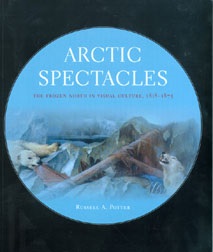 Artic Spectacles, The Frozen North in Visual Culture, 1818-1875 by Russell A. Potter.
Artic Spectacles, The Frozen North in Visual Culture, 1818-1875 by Russell A. Potter.
Arctic exploration was a popular theme. One event that contribted to its popularity was the disappearance of the Franklin
Expedition in the mid 19th century, the most sensational story of the day. Two great sailing ships carrying 129 men, sailed from England to the Arctic in search of the Northwest Passage and were never heard from again. The search continued over many
years inspiring artists to create moving panoramas to tell the stories.
There were more than 20 moving panoramas devoted to Arctic exploration. Sadly, none of the scrolls survived. The engraving
above is a program key to the North Coast of Spitzenbergen, a stationary (not cranked), 360 degree panorama that was displayed in 1819/20. This gives us a glimpse of what the moving
panoramas might have looked like.
Another way to get a better understanding of these moving panoramas is to explore the writings of Russell
A. Potter who has spent decades reseaching stories and collecting Victorian era Arctic artifacts. His book, Arctic Spectacles, is a fascinating read about moving panoramas
of the day and lists all the known Arctic moving panoramas in chronological order. Visit his blog Visions of the North.